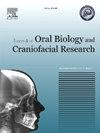使用改良的微孔板固定技术辅助植入物稳定
Q1 Medicine
Journal of oral biology and craniofacial research
Pub Date : 2025-06-30
DOI:10.1016/j.jobcr.2025.06.019
引用次数: 0
摘要
目的在许多临床病例中,截骨术周围的手术缺陷不能提供足够的稳定性,这可能会损害插入的种植体。使用微孔板固定可以通过提高植入物的稳定性来解决这个问题。本研究旨在评估利用微孔板固定受损骨缺损辅助种植体的稳定性。方法在犬股骨模型上造2个直径分别为6mm和4mm的截骨缺损。牙种植体(直径4毫米,长度10毫米)被放置在两个缺陷。微孔板用于增强受损种植体放置在较大缺陷尺寸的初始稳定性,而无需额外使用骨移植物。8周后进行反向扭矩测试和组织形态学分析以评估骨种植体接触(n = 48)。结果钢板种植体与对照种植体的骨与种植体接触率基本相同,分别为82.55±0.61和82.86±0.69。两组种植体骨接触量(t = 1.155, P = 0.260)和反向扭矩测试(t = 1.408, P = 0.173)差异均无统计学意义。结论辅助种植体稳定可以改善初始稳定性差的种植体的骨整合,无需采用骨移植或其他复杂的技术。本文章由计算机程序翻译,如有差异,请以英文原文为准。
Assisted implant stabilization using a modified microplate fixation technique
Objectives
In many clinical cases, the surgical defect around the osteotomy does not grant sufficient stability which may compromise the inserted dental implant. Using a fixation microplate may solve this issue by improving the stability of the inserted implant. This study aimed to evaluate assisted implant stability using microplate fixation in compromised bone defects.
Methods
Two osteotomy defects (6 mm and 4 mm in diameter) were made in the femur of a dog model. Dental implants (4 mm in diameter and 10 mm in length) were placed in the two defects. Microplates were used to enhance the initial stability of the compromised implant placed in the larger defect size without the need for the additional use of a bone graft. A reverse torque test and histomorphometric analysis were performed after eight weeks to assess bone implant contact (n = 48).
Results
Both plate and control implants had almost identical bone-to-implant contact ratios, 82.55 ± 0.61 and 82.86 ± 0.69, respectively. The two tested implants had no statistically significant difference in bone implant contact (t = 1.155, P = .260) nor reverse torque test (t = 1.408, P = .173).
Conclusions
Assisted implant stabilization improved osteointegration of implants suffering from poor initial stability without the need to resort to bone graft or other complicated techniques.
求助全文
通过发布文献求助,成功后即可免费获取论文全文。
去求助
来源期刊

Journal of oral biology and craniofacial research
Medicine-Otorhinolaryngology
CiteScore
4.90
自引率
0.00%
发文量
133
审稿时长
167 days
期刊介绍:
Journal of Oral Biology and Craniofacial Research (JOBCR)is the official journal of the Craniofacial Research Foundation (CRF). The journal aims to provide a common platform for both clinical and translational research and to promote interdisciplinary sciences in craniofacial region. JOBCR publishes content that includes diseases, injuries and defects in the head, neck, face, jaws and the hard and soft tissues of the mouth and jaws and face region; diagnosis and medical management of diseases specific to the orofacial tissues and of oral manifestations of systemic diseases; studies on identifying populations at risk of oral disease or in need of specific care, and comparing regional, environmental, social, and access similarities and differences in dental care between populations; diseases of the mouth and related structures like salivary glands, temporomandibular joints, facial muscles and perioral skin; biomedical engineering, tissue engineering and stem cells. The journal publishes reviews, commentaries, peer-reviewed original research articles, short communication, and case reports.
 求助内容:
求助内容: 应助结果提醒方式:
应助结果提醒方式:


